Barangaroo: explore this interesting Sydney destination
A Self-Guided Walk in Barangaroo
Download the Walking Map and Notes
Barangaroo is a place of work, a place to meet and definitely a place to explore. While this modern precinct close to the heart of the City of Sydney is a long way from completion (the final stages including a Metro Station are due to open in 2024), there is already much to discover.
Brief Historical Introduction
Known as Millers Point in colonial times, Barangaroo has strong links to Australia’s Aboriginal history and to modern Sydney’s maritime history. Many will know that Barangaroo is named after a strong Cammaraygal woman, an Aboriginal leader whose second husband, Bennelong was a key figure in early colonial history.
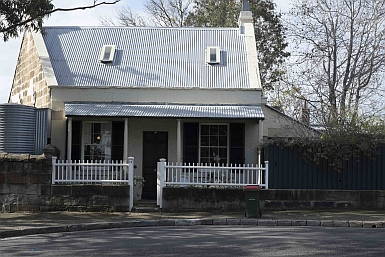

Before and during early colonial times, Aboriginal people used to fish and hunt around the area that is now called Barangaroo. Aboriginal Cultural Tours in Barangaroo teach visitors about the local Aboriginal history and culture.
Wynyard Walkway
Getting to Barangaroo from Wynyard Station is an easy walk through the Wynyard Walkway. First though, I step aside from the throng of suited workers rushing to their desks to observe a wonderful sculpture. It is awesome (in the real sense of the word) how the old wooden escalators at Wynyard Station have been repurposed.
In creating “Interloop”, Chris Fox used two hundred and forty-four old wooden escalator treads which now twist and loop above the new modern escalators. One of my favourite sculptures in Sydney, “Interloop” evokes memories for so many people of taking the wooden escalators at Wynyard.
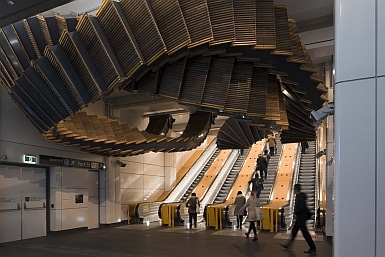

Office workers walk purposefully through the Wynyard Walk tunnel in a steady stream. Stopping for a minute to observe, I hear the dull sound of hundreds of footsteps punctuated occasionally with the clip clop of heels.
Here too is history. The tunnel, lit from above by a wavy beam of light is a gallery of sorts. At intervals, large screens display a selection of rotating photographs depicting the early life and buildings of Wynyard Station.
At the end of the tunnel, a man plays a familiar piece on his xylophone. Another man diverts from his path of travel to cut across the stream of people and drop a coin into the buskers open case.
Exiting the Wynyard Walkway Tunnel
At the top of the stairs, the reddish brickwork with arched windows and doorways of the Sussex Hotel faces me. A huge red crane is visible behind building hoardings decorated with the artwork “Sydney Opera House at Night” by Emily Crockford.


I buy a Big Issue for my train ride home. In answer to my question, the vendor tells me “yes, it is a bit cold” but that this position is “a good spot for sales”. I wish him a good day and walk on.
Barangaroo South
When on the bridge that traverses Sussex Street, I suddenly realise what is ahead and exclaim to myself “There it is”. “It” being Australia’s first and at the time the world’s tallest engineered timber office building. It is quite distinctive when you know what to look for. The exposed diagonal beams made from cross laminated timber (CLT) are part of the building’s beauty.
With so much glass around, the reflections make it difficult to take a reasonable photo, and I try again from street level. A man taking a smoko, smiles as he watches me. I wonder if the workers in this interesting building know the provenance of their work place.


A Public Art Destination
There is a comprehensive plan to establish Barangaroo as a major public art destination. Outside the distinctive Macquarie Bank on Shelley Street, is a cluster of what seem to be enormous, larger than life pottery bowls or vases. I’ve recently discovered that they are “Anenome”, created in 2009 by Anton James. Four of the vessels hide air vents from the car park below. What a great way to disguise essential but visually unappealing infrastructure.
Opposite the coffee mugs a squonky circle of bronze tubes reminiscent of organ pipes surrounds what is possibly a utility structure. Flat bronze pieces with phrases and sentences etched into them intersperse the tubes. They tell a story of Barangaroo and the original inhabitants of this area.


I read that the Aboriginal words for daughter are durunang and dilbung dilboong. The latter means small brown bird. Barangaroo and Bennelong called their daughter Dilboong. Unfortunately, this sculpture has become an area where smokers congregate. Again, I can’t find any more information about this interesting piece.
Feeling Uncomfortable
As I walk towards the Darling Harbour foreshore, two men wearing high viz vests and Barangaroo identification walk towards me. I brace myself. Photographer friends have been accosted by security for taking photos. I’m ready with my “spiel” as the Barangaroo Delivery Authority who manages Barangaroo has rules of behaviour which state that people may not take photos (without authorisation) for commercial purposes. The men walk past me without a more than a glance in my direction. Perhaps my friends were the early guinea pigs when Barangaroo had only just opened.
Barangaroo South is home to many financial institutions. It is a small densely populated area. There are plenty of nice looking cafes and restaurants and it’s an easy place to wander through. Bourke Street Bakery has a branch here. As in the original Surry Hills bakery, there is a queue out the door. I wait in line to order a coffee and small quiche and then settle at an outdoor table.
When my name is called I get up to collect my coffee returning to find the man at the table next to mine shooing a sea gull away from my quiche. Fortunately, he got there before the pesky gull.

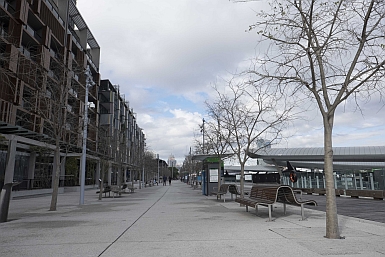
Barangaroo has plenty of interesting architecture. Barangaroo House is one such building. Dedicated to a number of restaurants it looks like three baskets nested into one another. Staff there are setting tables, preparing for the day.
Nearby is Shell Wall 2015, a collaboration between Aboriginal artists Esme Timbery and Jonathan Jones. The seven-storey installation celebrates the shell-work tradition of La Perouse and is a reminder of the shell middens found in the area now known as Barangaroo. This piece was the first commissioned under the Barangaroo Public art and Cultural Plan.


Wulugul Walk
Another way to get to Barangaroo is by ferry. The ferry wharf opens onto the Wulugul Walk which runs along the water’s edge and currently ends at the construction zone for Barangaroo Central and the Barangaroo Metro station.
The building hoardings screening the construction site provide a canvas for a detailed artwork, Aurora Eora. By Tony Albert, the work was created as part of Art Month 2017 and pays homage to Barangaroo and (in the artists words) “all Eora women whose custodianship of Sydney’s waterways has ensured it remains one of the most beautiful harbours in the world today”
Three enormous flags hang from a great height in the reception areas of each of the three International Towers. Of course, I know the Aboriginal flag and the Australian Flag.

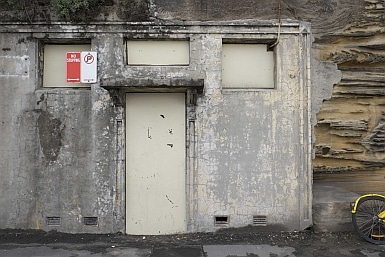
The third flag, I am embarrassed to admit is not familiar. On the central green panel (separated from two outside blue panels by a thin black stripe) is a white headdress and central star. I guess (and later confirm) that it is the Torres Strait Islander flag.
The Hungry Mile
The area now called Barangaroo played an important role in early colonial maritime history. The first wharfs were constructed in the 1820s. Walking along Hickson Road towards Barangaroo reserve, my mind turns to when this stretch of road was known as the Hungry Mile. During the depression years, workers would walk from wharf to wharf seeking work. Today, the area on the water side is a huge building site.
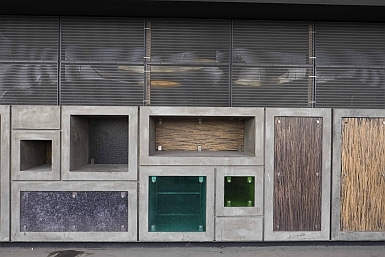

Barangaroo Reserve
The Wulugul Walk picks up again at Nawi Cove. One day you will be able to walk uninterrupted along the foreshore from Millers Point to Pyrmont. Lined with large sandstone blocks, Nawi Cove is named after the Aboriginal word for the simple blackwood canoes used by Barangaroo and other Eora women when they went fishing.
Barangaroo Reserve is a six-hectare parkland whose waterside reflects the 1836 shoreline. Munns Slipway and Cuthbert’s sandstone seawall were uncovered during development work on the park. The seawall was carefully moved and there is reference to Munns Slipway in Nawi Cove.


Children on a school excursion draw the banksia cones that they see growing on a tree in front of them. Thousands of native trees, plants and shrubs, many of which are native to Sydney Harbour, were used when landscaping Barangaroo Reserve.
Harbour Views
While walking along Wulugul Walk, I look back across the water to my left to Pyrmont and the ANZAC Bridge. Directly ahead on the other side is Balmain and further along across the harbour is Luna Park and Lavender Bay. It is a special feeling to know that I have walked all these suburbs over the last year or so and am much more familiar with them today than I was previously. Towards the end of the walk is a Queen Anne-style building 100m from its original location. It was a Pump Station and now serves as a toilet block.
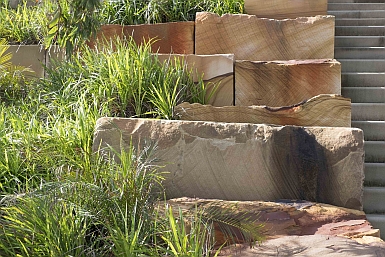

Stargazer Lawn
At intervals along the foreshore walk are sets of stairs up to the Stargazer Lawn. The view from this lawn towards the Sydney Harbour Bridge is beautiful especially on this unusually warm winter day. Nearby is the iconic Palisade Hotel. The view of the New Year’s fireworks would be amazing from the roof top or front facing rooms. Unfortunately, the cost is well out of my reach. As it’s too early for a cocktail at the rooftop bar, I make my way back to Wynyard Station via Hickson Road.
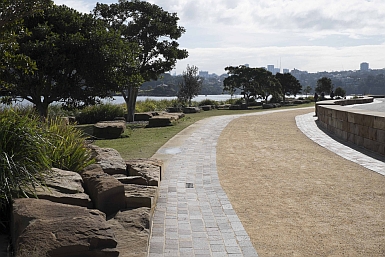

Bangaroo – Definitely Worth a Visit
Barangaroo is so much more than a place of work or place of residence. Barangaroo is definitely a destination and worth taking a look beneath the surface to find out more about the art, architecture and natural environment.
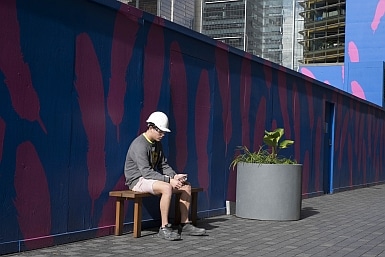
Useful information:
Barangaroo is in Sydney’s Inner City and is on the north western edge of the Sydney CBD
Plan your trip at transportnsw.info
Aboriginal Tours last an hour and a half and can be booked here.
For more information about the Shell Wall 2015 click here.
You can download a map of Barangaroo Reserve here.
Walking Map and Notes
And a map to assist you: You can download the map here (NOTE that the time indicated on the map does not allow for any stops. I take an average of 4-5 hours when I explore):


I often walk along Barangaroo to get to Walsh Bay and have missed so much of this artwork. I’ll look more carefully next time – thanks.
Yes, it is interesting how much artwork there is – and perhaps more to come.
Great descriptions Jo; made for enjoyable reading.
Thanks Robyn. I had fun discovering Barangaroo.
I love reading about your wanderings. We are drawn back to Barangaroo time and time again. However, despite many visits, you have shown me some more things to watch out for next time we leave Wynyard Walk, which, as it happens, will be next week. Camera at the ready I’ll see if I can find what we have previously missed.
Thank you Valerie. I am glad to have found things that regulars don’t know about. I hope you find them. And perhaps more.
Jo,
You’ve done it again ! Recently experienced this fantastic area of Sydney for the first time and despite the ongoing construction felt it was a great afternoon out. The walk along the water’s edge and the spectacular sandstone work is so impressive. After reading your perspectives it’s obvious I’ve missed a bit. Can’t wait to go back for a second take. Thank you.
Thank you Suzanne. I can’t believe it took me so long to get there – now it will become a regular destination.
I love the contrast between “Interloop” and the modern walk tunnel with its wavy beam of light and Barangaroo house looks so organic amongst the glass faced buildings surrounding it.
Reading about the history of hungry mile is a reminded of a grim and less affluent time, your photographs depict it well. Thanks for a great post.
An interesting insight Bernadette comparing Interloop and the walk tunnel. I am learning so much from my walks and research.
I really enjoy going to barangaroo, for the restaurants, the lovely green parkland, and excellent people watching. I just wish the developers/planners had thought to put a playground in there too. The one at darling harbour is excellent, but it’s the only one in the city.
Yes, Georgie – Great people watching in Barangaroo. My grandson loves the Darling Harbour playground.
One of our sons works at Barangaroo and D and I often head into town to meet him for lunch. We usually take our bikes and head off for a quick cycle around Blackwattle Bay after eating too much. It makes for a great afternoon out.
Sounds like a great combination of family time, lunch and a pleasant cycle.